The collapse of the sea wall at Dawlish in February 2014 brought to the fore the need to protect the railway from the sea. Richard Clinnick reports on the subsequent project which has transformed Dawlish.

Speaking at an event at Dawlish on July 3, to mark the completion of the new sea wall, Network Rail Wales and Western region regional managing director Michelle Handforth said: “The line is a vital transport link for the south west, something that was starkly highlighted when sections of the railway were washed away and flooded during an intense storm in 2014.
“Enhancing the resilience of this coastal stretch of line is vitally important for the region, especially given the challenges posed by climate change and the increasing frequency of extreme weather.
“Working with world-leading engineers and with funding from the Government, we’ve been able to protect the railway line and town of Dawlish for generations to come.”
However, there is work left to do at the famous Devon seaside town. The event was able to showcase the huge undertaking by Network Rail and its contractor BAM Nuttall in carrying out resilience work which will keep trains running along the wall west of Exeter.
And this was needed, as the events of less than a decade proved.
February 2014 was a bad time for Devon’s railways. Within the space of 10 days, two powerful storms caused 100-metres of the sea wall to collapse at Dawlish, cutting off the peninsula from the rest of the country’s national rail network.
The financial impact on the region for the 50 weekdays that the line was closed was estimated at £1 billion with that figure based on the £20 million per day suggested as the cost to the area after flooding closed the railway at Cowley Bridge, near Exeter, only a few months earlier.
During the evening of February 4, 2014, a storm brought south-easterly winds which helped the sea punch an 80-metre-long hole in the wall east of Dawlish station. Repairs were already quickly underway when, 10 days later, on February 14, a further 20 metres collapsed as storms continued to batter the region. The eventual bill to Network Rail to repair the wall was some £35 million, but the impact was much greater.
Trains were forced to terminate at Exeter St Davids and Newton Abbot. First Great Western (FGW) had to move trains by road across the hills behind the coastal route to enable services to continue operating, and for routine maintenance to be undertaken.
This catastrophic incident brought forward discussions regarding what was needed to be done to protect the railway. Network Rail, and government, set about investigating what was possible.
Various options were considered, and continue to be debated to this day, but included consideration being given to reopening either the route via Okehampton and Tavistock (the central part of which closed in 1968), or the Teign Valley via Heathfield as diversionary routes (the latter closed to passengers in 1958, and was severely affected by flooding in 1961, before finally closing in 1967). Other options included a breakwater in the English Channel. Three separate studies were carried out in 2014, 2016 and 2018.
Since 2014, NR has been developing plans to improve the railway’s resilience for the 20-mile stretch of railway between Exeter and Newton Abbot. As a result of this, the South West Rail Resilience Programme was established to identify and implement the best options to improve resilience between Dawlish and Teignmouth.
In November 2018, a nine-month project began to repair the breakwaters already in situ at Dawlish as it was deemed that these were not providing adequate protection. Work then began to replace the existing sea wall at Marine Parade, Dawlish in May 2019.
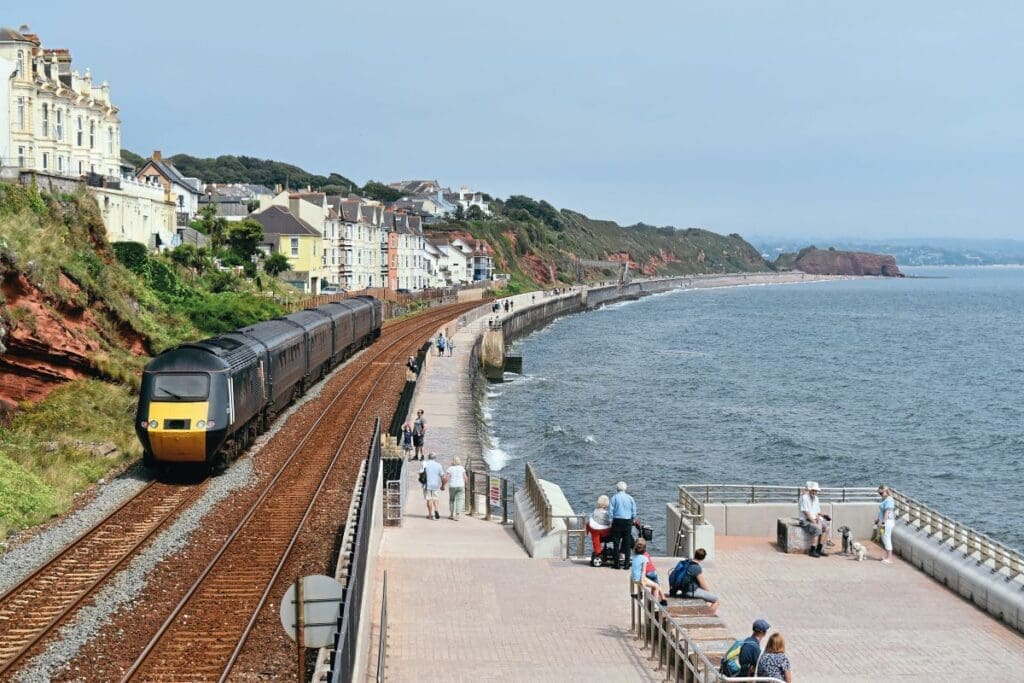
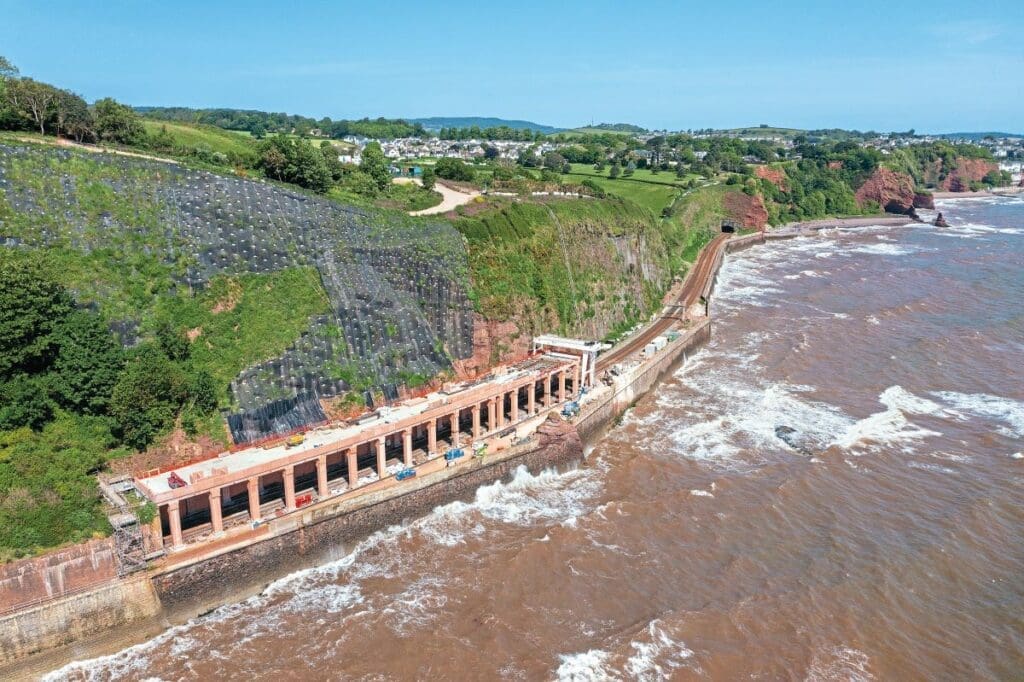
Five phases
The workload has been significant. With the completion of the second phase (although there is some work left to do on the station), Network Rail and its contractor BAM Nuttall has so far installed 1799 precast units as well as 28,360 sq m of concrete. This has required 1,220,000 working hours. And the resilience scheme is not complete.
The first section (Phase 1) was completed in July 2020, and features a 360-metre length of wall along Marine Parade to Boat Cove (next to Kennaway Tunnel). This officially opened in September 2020, having taken 14 months to build. This was designed without the knowledge that the following phases would be approved. There was hope, but no expectation. Emma Lewis, programme engineering manager, says that the station, for example, was not included in the initial plans.
For Phase 1, Network Rail and its contractors BAM Nuttall built a new foundation in front of the existing sea wall which was then clad with panels and backfilled with concrete. Recurve units, which send the water and spray upwards and back to the sea rather than onto the railway, were then placed on top of the new construction.
A new railway boundary upstand wall and fence was also installed to improve public safety near the track, while new seating and low-energy LED lighting was also installed.
This phase features 8531m3 concrete, weighing some 20,474 tonnes. All told there was 350,000 working hours required to undertake this part of the project, and these included working during the Covid pandemic. Rob Newton, Network Rail senior construction manager explained that during that period, where possible, the two-metre space between people was adhered too. He admitted that material was delayed due to the pandemic; however, this affected the second phase rather than the Marine Parade element of the project. The pandemic also required the casting of some sections of the new structure on site rather than further afield to keep on schedule.
Phase 2, which is the sea wall between Colonnade and Coastguard breakwaters (known as C2C), was officially opened by Secretary of State for Transport Mark Harper on July 3, 2023.
This 415-metre section also included work around Dawlish station. Between November 2020 and February 2021, a ‘wavewalker’ jack-up barge was on site to carry out the piling for this section. This eight-legged machine was the only one of its kind in Europe and this was also the first time that this type of barge had been used to maintain the UK rail network. Using this allowed Network Rail to work across a range of tides. Later, more work in a more confined space has been dependent on the tide.


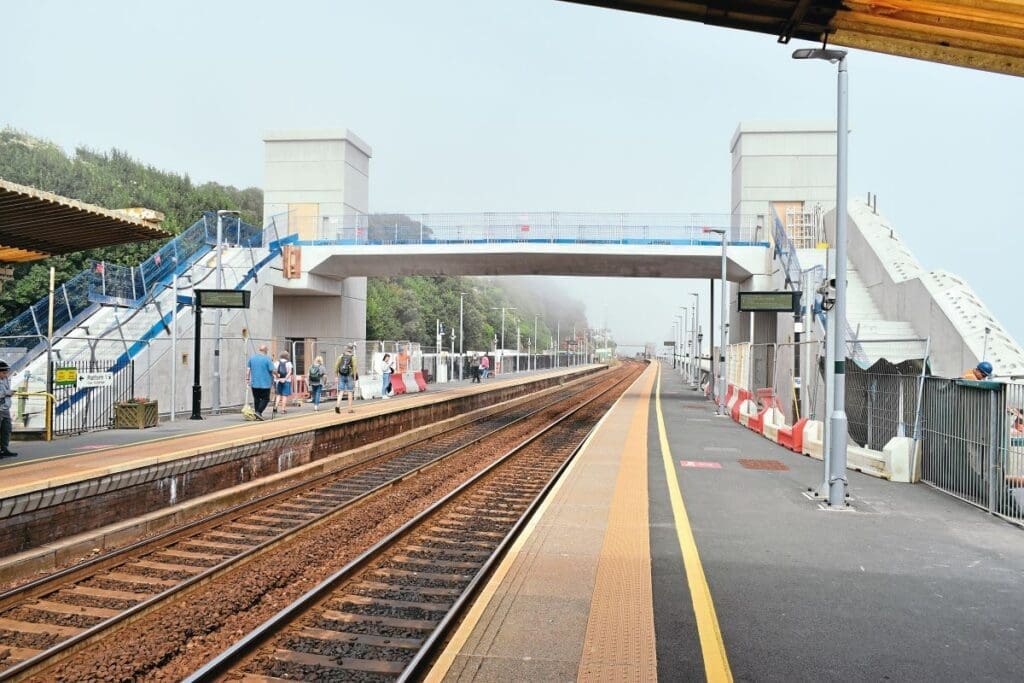

Other large items of equipment were delivered to site by barge, while pre-cast segments were delivered by road. Rob explains that the shifts were tidal because of the nature of where the project was being undertaken. The staff were there in all weathers: “at times the rain was coming sideways,” he laughs. Some logistical planning was needed at times due to the surrounding conditions; remember, the railway rarely closed during this project while everything was also reliant on the tides – it really was an enclosed workspace for such a major project.
Emma admits that there had to be design constraints because of the weather, for instance the laying of foundations had to be rapid due to the time available, and so this was factored into the plans. “It was good fun,” she says.
Phase 2 features 164 wall panels, 203 pre-cast blocks and 189 recurve units. The wall panels range in height from 6.06 metres to 6.69m, and in weight from 11.55 tonnes to 12.95t. Network Rail said that the concrete used to backfill behind the new sea wall panels is low carbon, which it says has two-thirds less carbon than standard concrete.
A new stilling basin has been constructed where Dawlish Water runs into the sea. This is of a more robust construction than the previous one and will also help to return waves. Across this basin, a new pedestrian link has been constructed (which offers good vantage points for photography). Network Rail says that Phase 2 has plenty of “nods to the old” in its design, including reusing stone for benches and echoing the location of the station seating alcoves and the old boathouse on the new wall panels.
Accessibility is also key and the new wall on Phase 2 is fully accessible with a ramp from the Colonnade to join the link bridge, thus creating a step-free access all the way from Boat Cove to Dawlish Warren. There is also a ramp down onto both sides of the beach at Colonnade. A further part of this accessibility work is the realignment of the platforms at Dawlish station to reduce the stepping distance.
The accessible station footbridge, which when open later this year will feature lifts, will allow the closure of the barrow crossing at the station.
The combined cost of Phases 1 and 2 is £80 million. There were lessons taken from Phase 1 to Phase 2, such as using pre-cast components.
Phase 2 is split into two phases (2A and 2B). Phase 2B comprises the sea wall around the station and the area around Dawlish Water, plus the alterations to the platforms. The new footbridge is independent of the new wall which means that should the new wall be hit or damaged by the elements, the bridge remains secure.
Phase 3 is also visible from the wall and station. This is Parson’s Tunnel North Portal rockfall shelter. Here, Network Rail is installing a new rockfall shelter at the northern end of Parson’s Tunnel, between Dawlish and Holcombe.
Permission was granted for a 209-metre-long structure here; however, the decision was taken to halve the open-sided shelter in length to save money and reduce the project’s carbon footprint.
Analysis showed that the same resilience along the remaining 104m can be achieved by installing rock anchors and netting. It is believed that this will keep the cliff material in place, rather than letting it degrade.
The 185 pre-cast concrete sections were installed by using a rail-mounted gantry crane. Rob explains that the material was delivered by rail with trains running from Newton Hackney Yard to the site. Meanwhile slabs have also been cast on site as trains have been operating. Some 7000 sq m of mesh, secured by soil nails, has also been installed on the cliff face. Network Rail says that while it looks stark now, the vegetation has already started to grow back through the mesh. This shelter is expected to be completed during the autumn.
A fourth Phase (see Headline News) involves protecting the cliffs between Dawlish and Holcombe. This covers the railway between Dawlish and the work at Parson’s Tunnel and includes installing netting designed to retain the cliffs in some high-risk locations, and catch fences, which will stop any cliff material before it reaches the railway. The selection process for the contractor emphasised the environmental considerations of the project. Vegetation clearance has been completed and the main work began at the end of July. Network Rail and BAM are working with Natural England on the areas that fall within the Dawlish Cliffs Site of Special Scientific Interest.
Phase 5, which runs from Parson’s Tunnel to Teignmouth, has not been costed says Emma, but is seen as a vital part of the project. Network Rail says that in 2020 it conducted a second round of consultation on its proposals to realign the railway to make room for corrective measures designed to stabilise the cliffs. Following public feedback, it committed to fully reviewing the scheme and now is proposing resilience measures that reduce the impact on the beach and leave the railway where it is. The immediate risk from the cliffs rather than the sea was recognised by Network Rail and so a decision was made to see if managing the cliffs without moving the railway or tackling the sea wall was possible. Over a two-year period, extensive analysis of existing data and trials of ground investigation techniques have been carried out to further assess the risk from the cliffs to the railway. More site investigations are under way.
Current investigations include groundwater monitoring, flow monitoring of permanent and intermittent streams, rock anchor pull-out tests, trial boreholes to determine the best ways to obtain samples up to 65m deep, rope access surveys to look at discontinuities and other geological features, and a CCTV survey of the track drainage system.
Depending on the level of risk, the cliffs could be stabilised with a range of targeted solutions from soil nailing and netting to groundwater management.
The project has been a success, so far, says Rob. “Both Great Western Railway and CrossCountry both say there have been fewer incidents caused by the sea.”
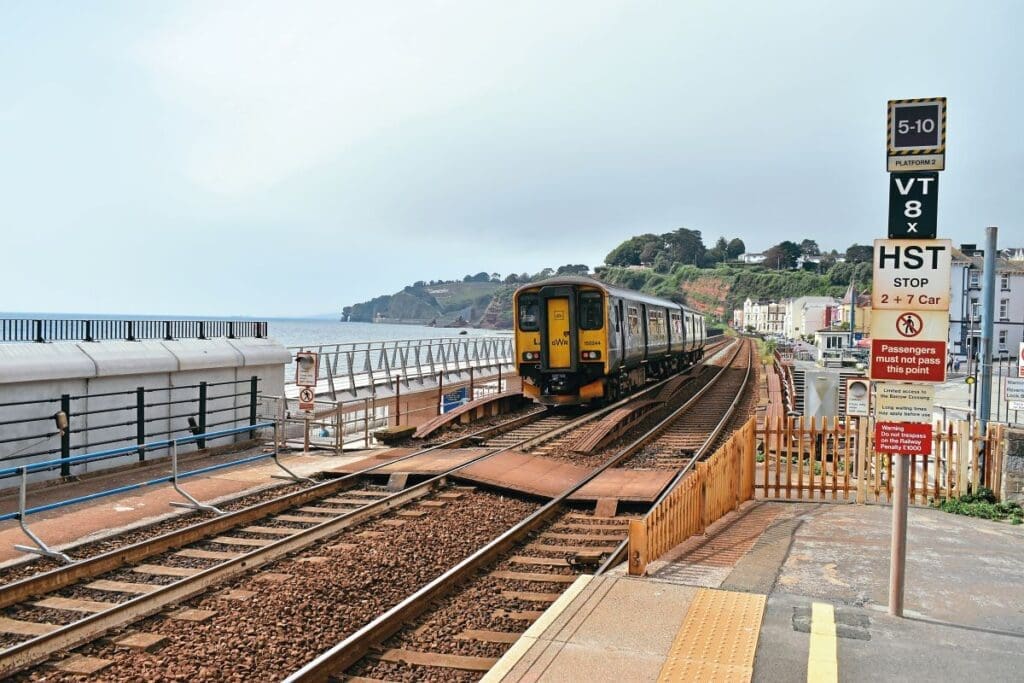
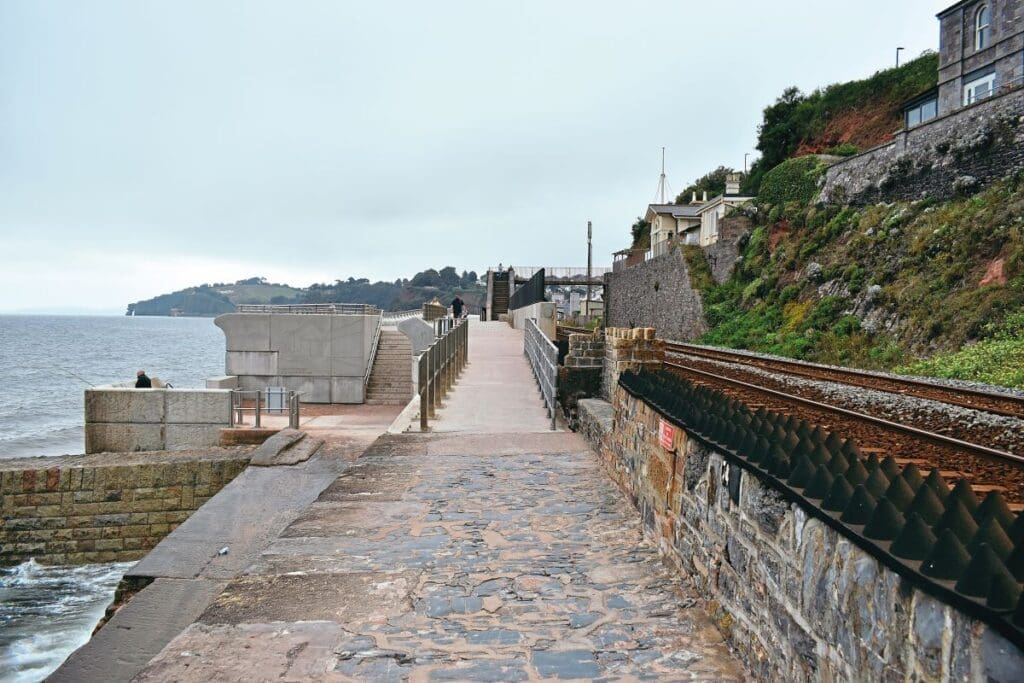
Phase 1 (Marine Parade) statistics
- 15 balustrade units in Town Gateway ramp
- 32 upstand units on Town Gateway ramp
- 145 facing panels
- 179 recurve units (not including the link bridge approach)
- 281 blocks in Town Gateway ramp
- 825 total precast units
- 8531 metre3 concrete placed
- 20,474 tonnes – weight of concrete placed
- 350,000 working hours on phase 1
Source: Network Rail.
Phase 2A (Colonnade to Coastguard) statistics
- 47 bored cast in-situ piles installed
- 78 blocks
- 143 facing panels
- 144 promenade units
- 155 recurve units
- 286 CHS piles installed
- 500 metres of station platform renewal
- 520 precast units
- 11,043 metres3 concrete placed
- 26,503 tonnes – weight of concrete placed
- 876,000 working hours on phase 2 (includes phases 2a and 2b)
Source: Network Rail
Phase 2B (Colonnade to Coastguard) statistics
- 10 eel ramp units
- 12 promenade units
- 15 spillway slabs
- 16 lift bridge piles
- 21 facing panels
- 26 spillway stepped units
- 42 CHS piles
- 48 recurve units
- 51 link bridge piles
- 55 units
- 56 L-units
- 67 bored cast in-situ piles installed
- 211 blocks
- 454 precast units total
- 8786 metres3 concrete placed
- 21,086 tonnes – weight of concrete placed
Source: Network Rail.


